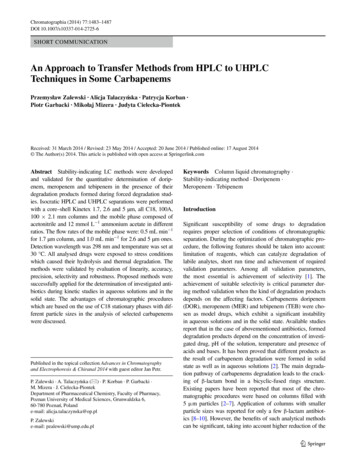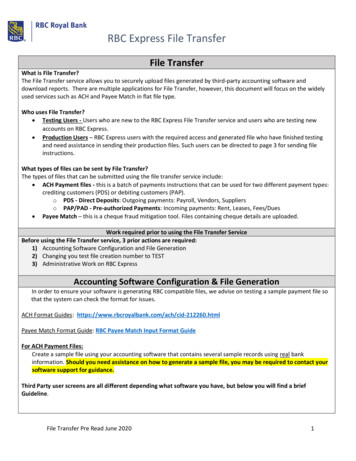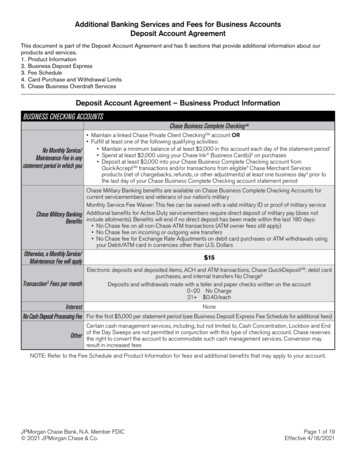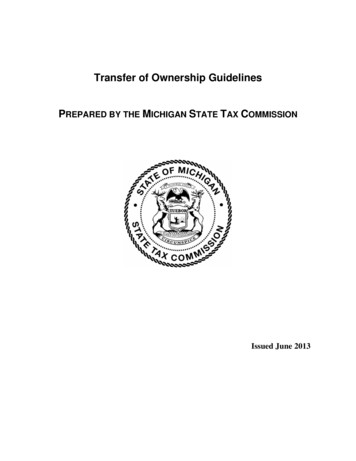
Transcription
Chromatographia (2014) 77:1483–1487DOI 10.1007/s10337-014-2725-6SHORT COMMUNICATIONAn Approach to Transfer Methods from HPLC to UHPLCTechniques in Some CarbapenemsPrzemysław Zalewski · Alicja Talaczyńska · Patrycja Korban ·Piotr Garbacki · Mikołaj Mizera · Judyta Cielecka‑PiontekReceived: 31 March 2014 / Revised: 23 May 2014 / Accepted: 20 June 2014 / Published online: 17 August 2014 The Author(s) 2014. This article is published with open access at Springerlink.comAbstract Stability-indicating LC methods were developedand validated for the quantitative determination of doripenem, meropenem and tebipenem in the presence of theirdegradation products formed during forced degradation studies. Isocratic HPLC and UHPLC separations were performedwith a core–shell Kinetex 1.7, 2.6 and 5 µm, all C18, 100A,100 2.1 mm columns and the mobile phase composed ofacetonitrile and 12 mmol L 1 ammonium acetate in differentratios. The flow rates of the mobile phase were: 0.5 mL min 1for 1.7 µm column, and 1.0 mL min 1 for 2.6 and 5 µm ones.Detection wavelength was 298 nm and temperature was set at30 C. All analysed drugs were exposed to stress conditionswhich caused their hydrolysis and thermal degradation. Themethods were validated by evaluation of linearity, accuracy,precision, selectivity and robustness. Proposed methods weresuccessfully applied for the determination of investigated antibiotics during kinetic studies in aqueous solutions and in thesolid state. The advantages of chromatographic procedureswhich are based on the use of C18 stationary phases with different particle sizes in the analysis of selected carbapenemswere discussed.Published in the topical collection Advances in Chromatographyand Electrophoresis & Chiranal 2014 with guest editor Jan Petr.P. Zalewski · A. Talaczyńska (*) · P. Korban · P. Garbacki ·M. Mizera · J. Cielecka‑PiontekDepartment of Pharmaceutical Chemistry, Faculty of Pharmacy,Poznan University of Medical Sciences, Grunwaldzka 6,60‑780 Poznań, Polande-mail: alicja.talaczynska@op.plP. Zalewskie-mail: pzalewski@ump.edu.plKeywords Column liquid chromatography ·Stability-indicating method · Doripenem ·Meropenem · TebipenemIntroductionSignificant susceptibility of some drugs to degradationrequires proper selection of conditions of chromatographicseparation. During the optimization of chromatographic procedure, the following features should be taken into account:limitation of reagents, which can catalyze degradation oflabile analytes, short run time and achievement of requiredvalidation parameters. Among all validation parameters,the most essential is achievement of selectivity [1]. Theachievement of suitable selectivity is critical parameter during method validation when the kind of degradation productsdepends on the affecting factors. Carbapenems doripenem(DOR), meropenem (MER) and tebipenem (TEB) were chosen as model drugs, which exhibit a significant instabilityin aqueous solutions and in the solid state. Available studiesreport that in the case of abovementioned antibiotics, formeddegradation products depend on the concentration of investigated drug, pH of the solution, temperature and presence ofacids and bases. It has been proved that different products asthe result of carbapenem degradation were formed in solidstate as well as in aqueous solutions [2]. The main degradation pathway of carbapenems degradation leads to the cracking of β-lactam bond in a bicyclic-fused rings structure.Existing papers have been reported that most of the chromatographic procedures were based on columns filled with5 μm particles [2–7]. Application of columns with smallerparticle sizes was reported for only a few β-lactam antibiotics [8–10]. However, the benefits of such analytical methodscan be significant, taking into account higher reduction of the13
1484run time of analysis and shorter contact with reagents, whichcause the hydrolytic degradation of investigated substancesduring sample preparation and chromatographic analysis [11,12]. Therefore, it is such an important study of transfer fromHPLC procedure to UPLC separation in the case of labiledrugs. The aim of our studies was to select the best analyticalconditions for the determination of labile carbapenem analogues, in the presence of their degradation products.ExperimentalStandards and ReagentsDORIBAX (Janssen-Cilag International NV, Beerse, Belgium) containing doripenem monohydrate as an anhydrousbasis form was used as doripenem standard. Meropenem(purity 98 %) was obtained from CHEMOS (Regenstauf,Germany). Tebipenem (purity 98 %) was supplied byPharmachem International (Wuhan, China). All other chemicals and solvents were obtained from Merck KGaA (Darmstadt, Germany) and were of analytical grade. High-qualitypure water was prepared using a Millipore Exil SA 67120purification system (Millipore, Molsheim, France).InstrumentationThe Dionex Ultimate 3000 analytical system consistedof a quaternary pump, an autosampler, a column ovenand a diode array detector. Three Kinetex, C18, 100A,100 2.1 mm columns (Phenomenex, Torrance, USA)with different particle sizes (1.7, 2.6 and 5 µm) were tested.The mobile phase composed of acetonitrile and 12 mmolL 1 ammonium acetate in different ratios (Table 1). Theflow rate of the mobile phase was 1.0 mL min 1. The wavelength of the DAD detector was set at 298 nm. Separationwas performed at 30 C.Procedure for Forced Degradation Study of API’sDegradation in Aqueous SolutionsThe degradation of analysed API’s (active pharmaceuticalingredient) in aqueous solutions was studied at 293 K insodium hydroxide solution (0.3 mol L 1) and at 353 K inhydrochloric acid (0.3 mol L 1). The ionic strength of allsolutions was adjusted to 0.5 mol L 1 with a solution ofsodium chloride (4.0 mol L 1). Degradation was initiatedby dissolving an accurately weighed 5.0 mg of analyseddrug in 10.0 mL of the solution equilibrated to the desiredtemperature in stoppered flasks. At specified times, samples of the reaction solutions were neutralised and instantlycooled with a mixture of ice and water.13P. Zalewski et al.Degradation in Solid State5.0 mg samples of analysed API’s were weighed into 5 mLglass vials. To evaluate the influence of temperature andhumidity, the samples were placed in a desiccator containing saturated solution of sodium chloride (RH 76.4 %)that was in incubators (Wamed, Warsaw, Poland) set totemperature 333 K. At specified time intervals, determinedby the rate of degradation, the vials were removed, cooledto room temperature and their contents were dissolved inwater. The so-obtained solutions were quantitatively transferred into measuring flasks and diluted with the same solvent to 10.0 mL.Results and DiscussionChromatographic studies of β-lactam analogues are complicated due to their significant susceptibility to degradation, as well as possibility of catalytic effect of their degradation products to stability of parent compound.In this article, different analytical procedures basedon core shell C18 stationary phases with various particle sizes were evaluated. The fully porous C18 columnsfilled with 5 µm particles allowed the determination ofanalysed carbapenems in about 15 min [2–8]. Employment of core shell 5 µm particles technology leadedto essential reduction of retention times (tR) (Table 1).The determination of carbapenem analogues based onthe core shell C-18 columns with particles 2.6 µm didnot give significant benefits in regard to the reductionof retention times. However, this application produceshigher pressures. In the case of determination of carbapenems analogues using core shell C-18 columns with1.7 µm particles, the retention times represented similarvalues as in separation based on stationary phase withgreater particles, but simultaneously flow rate was twiceless (Table 1). This approach is compromised betweenreduction of consumption organic solvents and highpressure which appears in developed method with 5 µmparticles.Validation of analytical methods for the determinationof carbapenems using C-18 stationary phase with different particle sizes was conducted in regarding to linearity, precision, accuracy, LOD and LOQ. The significantreduce tR of carbapenem after application of core shellcolumns did not influence on separation of main peaks(meropenem, doripenem and tebipenem) from degradation products. Suitable symmetry of peaks of mainsubstances as well as related products was unchanged.Order of time retentions for all analytes was the sameas in the separation based on fully porous stationary phases. For all the analogues of carbapenems, the
1485An Approach to Transfer Methods from HPLC to UHPLC TechniquesTable 1 HPLC and UHPLC parameters for the determination of selected carbapenemsChromatographyconditionsColumn typeMobile phaseFlow rateDetection aphyconditionsDoripenemTechniques typeHPLC [7]HPLCLiChrospher C-18;5 µm; fully porous;250 4.6 mm12 mM ammoniumacetate–acetonitrile(96:4 v/v)1.2 mL min 1Kinetex C 18; 5 µm; core shell; Kinetex C 18; 2.6 µm; core100 2.1 mmshell; 100 2.1 mmKinetex C 18; 1.7 µm; coreshell; 100 2.1 mm12 mM ammonium acetate–acetonitrile (96:4 v/v)12 mM ammonium acetate–acetonitrile (96:4 v/v)12 mM ammonium acetate–acetonitrile (90:10 v/v)1.0 mL min 1298 nm0.823 min1.0 mL min 1298 nm0.869 min0.5 mL min 1298 nm0.666 min0.97244 bar30 C1.03822 bar30 C1.38710 bar30 C298 nm6.2 minMobile phaseFlow rateDetection aphyconditionsTechniques typeMobile phaseFlow rateDetection HPLCKinetex C 18; 2.6 µm; coreshell; 100 2.1 mm12 mM ammonium acetate–acetonitrile (93:7 v/v)1.0 mL min 1298 nm0.79 minKinetex C 18; 1.7 µm; coreshell; 100 2.1 mm12 mM ammonium acetate–acetonitrile (90:10 v/v)0.5 mL min 1298 nm0.584 min0.92273 bar30 C1.12825 bar30 C1.39710 bar30 CHPLCUHPLCUHPLCKinetex C 18; 2.6 µm; coreshell; 100 2.1 mm12 mM ammonium acetate–acetonitrile (90:10 v/v)1.0 mL min 1298 nm0.533 minKinetex C 18; 1.7 µm; coreshell; 100 2.1 mm12 mM ammonium acetate–acetonitrile (90:10 v/v)0.5 mL min 1298 nm1.16 min1.14287 bar1.12825 bar0.76682 bar30 C30 C30 CLiChrospher C-18; 5 µm; fullyKinetex C 18; 5 µm; coreporous; 250 4.6 mmshell; 100 2.1 mm12 mM ammonium acetate– 12 mM ammonium acetate–acetonitrile (92:8 v/v)acetonitrile (93:7 v/v)1.0 mL min 11.2 mL min 1298 nm298 nm4.32 min0.683 minTebipenemTechniques typeHPLC [3]Column typeUHPLCMeropenemHPLC [4]Column typeUHPLCLiChrospher C-18; 5 µm; fullyKinetex C 18; 5 µm; coreporous; 250 4.6 mmshell; 100 2.1 mm12 mM ammonium acetate– 12 mM ammonium acetate–acetonitrile (96:4 v/v)acetonitrile (93:7 v/v)1.0 mL min 11.2 mL min 1298 nm298 nm12.32 min0.87 minlinear relationships between concentration of analytesand response of detector were achieved. The widestranges of linear response were obtained when carbapenems were determined with usage of core shell columnswith 5 µm particles. Those determinations were characterised by the most satisfied regression coefficients.Table 2 shows linear response function of concentrationover the range 0.5–3.0 µg and regression coefficients(r) were 0.995 for all the carbapenems. Similar resultswere obtained for precision studies. It was shown thatthe lowest values of intra-day and inter-day precisionwere calculated in the cases of determination of DOR,13
1486Table 2 Linear range,regression data, and LODs andLOQs for analysis of selectedcarbapenemsP. Zalewski et al.Column enem1.72.65.0Regression equationy 39.330x 7.833y 20.285xy 22.324xR2Linearrange (µg)LOD (µg)LOQ 40.430.99970.25–3.000.030.09y 22.314x0.99990.05–3.000.010.02y 48.147x0.99990.50–3.000.010.03y 36.863x 11.004y 19.609xy 28.856xy .010.03Fig. 1 Inter-day (a–c) and intra-day (d–f) precision of determination of carbapenem analogues at 80 % (a, d), 100 % (b, e) and 120 % (c, f) levels of initial concentrationMER and TEB using C-18 column filled with 5 µm particles. Method repeatability data as accuracy are summarised in Fig. 1.Decreasing particle sizes from 2.6 to 1.7 µm in coreshell columns did not significantly influence RDS % values characterising intra-day and inter-day precision. Theaccuracy of determination of carbapenem analogues was13established at three concentration levels: 80,100 and 120 %of label claim. However, significant differences betweenaccuracy of determinations of carbapenems analogues werenot observed (Fig. 2a–c). The lowest values of LOD andLOQ for carbapenems were obtained when their determinations were conducted on core shell column filed with5 µm particles.
1487An Approach to Transfer Methods from HPLC to UHPLC TechniquesOpen Access This article is distributed under the terms of the Creative Commons Attribution License which permits any use, distribution, and reproduction in any medium, provided the original author(s)and the source are credited.ReferencesFig. 2 Recovery of determination of carbapenem analogues at 80 %(a), 100 % (b) and 120 % (c) levels of initial concentrationConclusionsIn the presented study, the influence of the particle size ofcore shell stationary phase on parameters of labile drugsdetermination was examined. An achievement of the mostsatisfactory validation parameters was possible when thedoripenem, meropenem and tebipenem were determinedusing core shell C-18, 5 µm stationary phases. The separation of carbapenems based on core shell C-18, 5 µm stationary phases is valuable due to short time of analysis,long vitality of column and possibility to work on classicalHPLC systems (dedicated for max pressure 400 bars).Acknowledgments This study was supported by a grant fromthe State Committee for Scientific Research, Poland (No. N N405683040).1. Sehrawat R, Maithani M, Singh R (2010) Regulatory aspects indevelopment of stability-indicating methods: a review. Chromatographia 72(1–2):1–62. Mendez A, Chagastelles P, Palma E, Nardi N, Schapoval E (2008)Thermal and alkaline stability of meropenem: degradation products and cytotoxicity. Int J Pharm 350:95–1023. Cielecka-Piontek J, Zalewski P, Barszcz B, Lewandowska K,Paczkowska M (2013) Stress degradation studies of tebipenemand a validated stability-indicating LC method. Chromatographia76(7–8):381–3864. Cielecka-Piontek J, Zajac M, Jelińska A (2008) A comparisonof the stability of ertapenem and meropenem in pharmaceuticalpreparations in solid state. J Pharm Biomed Anal 46(1):52–575. Matsuda T, Ikawa K, Ikeda K, Morikawa N, Tsumura R, Shibukawa M, Iida K, Kurisu K (2009) LC method for the determination of meropenem in cerebrospinal fluid: application to therapeutic drug monitoring. Chromatographia 69(9–10):1031–10346. Kipper K, Anier K, Leito I, Karjagin J, Oselin K, Herodes K(2009) Rapid determination of meropenem in biological fluids by LC: comparison of various methods for sample preparation and investigation of meropenem stability. Chromatographia70(9–10):1423–14277. Cielecka-Piontek J, Krause A, Zalewski P, Lunzer A, Jelińska A(2012) Development and validation of a stability-indicating LC–UV method for the determination of doripenem and biapenem inpharmaceutical dosage forms. Acta Chrom 24(2):207–2198. Reddy PRM, Prathyusha S, Shanmugasundaram P, Naidu PY,Hanumanaraju GV, Karthikeyan R (2014) Stability indicatingultra-performance liquid chromatography method for the simultaneous estimation of doripenem and its degradation products. JLiq Chrom Relat Tech 37(3):298–3109. Carlier M, Stove V, Roberts JA, Van de Velde E, De Waele JJ,Verstraete AG (2012) Quantification of seven β-lactam antibioticsand two β-lactamase inhibitors in human plasma using a validatedUPLC-MS/MS method. Int J Antimicrob Agents 40(5):416–42210. Wang L, Yuan-Qian Li Y-Q (2009) Simultaneous determinationof ten antibiotic residues in milk by UPLC. Chromatographia70(1–2):253–25811. Cielecka-Piontek J, Zalewski P, Jelińska A, Garbacki P (2013)UHPLC: the greening face of liquid chromatography. Chromatographia 76(21–22):1429–143712. Gumustas M, Kurbanoglu S, Uslu B, Ozkan SA (2013)UPLC versus HPLC on drug analysis: advantageous applications and their validation parameters. Chromatographia76(21–22):1365–142713
Table 1 HPLC and UHPLC parameters for the determination of selected carbapenems Chromatography conditions Doripenem Techniques type HPLC [7] HPLC UHPLC UHPLC Column type LiChrospher C-18; 5 µm; fully porous; 250 4.6 mm Kinetex C 18; 5 µm; core shell; 100 2.1 mm Kinetex C 18; 2.6 µm; core shell; 100 2.1 mm Kinetex C 18; 1.7 µm; core











